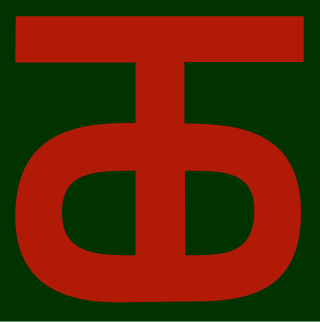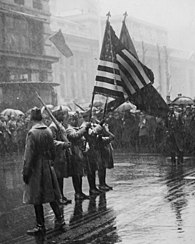
The 1st Infantry Division is a combined arms division of the United States Army, and is the oldest continuously serving division in the Regular Army. It has seen continuous service since its organization in 1917 during World War I. It was officially nicknamed "The Big Red One" after its shoulder patch and is also nicknamed "The Fighting First." The division has also received troop monikers of "The Big Dead One" and "The Bloody First" as puns on the respective officially sanctioned nicknames. It is currently based at Fort Riley, Kansas.

The 5th Armored Division ("Victory") was an armored formation of the United States Army active from 1941 to 1945 and from 1950 to 1956.

The 7th Armored Division was an armored division of the United States Army that saw distinguished service on the Western Front, from August 1944 until May 1945, during World War II.

The 8th Armored Division was an armored division of the United States Army that served in the European Theater of World War II.

The 14th Armored Division was an armored division of the United States Army assigned to the Seventh Army of the Sixth Army Group during World War II. It remains on the permanent roll of the Regular Army as an inactive division, and is eligible for reactivation. The division is officially nicknamed the "Liberators".

The 20th Armored Division was an armored division of the United States Army that fought in World War II. It was activated on 15 March 1943 at Camp Campbell in Kentucky.

The 104th Infantry Division was an infantry division of the United States Army. Today, it is known as the 104th Training Division (Leader Training) and based at Fort Lewis, Washington, as a training unit of the United States Army Reserve.

The 65th Infantry Division—nicknamed the "Battle-Axe Division"—was an infantry division of the United States Army that served in World War II. Its shoulder patch is a white halberd on a blue shield.

The 35th Infantry Division, formerly known as the 35th Division, is an infantry formation of the United States Army National Guard headquartered at Fort Leavenworth, Kansas.

The 84th Training Command ("Railsplitters") is a formation of the United States Army. During World War I it was designated the 84th Division, American Expeditionary Forces; during World War II it was known as the 84th Infantry Division. From 1946 to 1952, the division was a part of the United States Army Reserve as the 84th Airborne Division. In 1959, the division was reorganized and redesignated once more as the 84th Division. The division was headquartered in Milwaukee in command of over 4,100 soldiers divided into eight brigades—including an ROTC brigade—spread throughout seven states.

The 102nd Infantry Division ("Ozark") was a unit of the United States Army in World War II. The unit is currently active as the 102nd Training Division (Maneuver Support).

The 90th Infantry Division was a unit of the United States Army that served in World War I and World War II. Its lineage is carried on by the 90th Sustainment Brigade.

The 92nd Infantry Division was an African-American, later mixed, infantry division of the United States Army that served in World War I, World War II, and the Korean War. The military was racially segregated during the World Wars. The division was organized in October 1917, after the U.S. entry into World War I, at Camp Funston, Kansas, with African-American soldiers from all states. In 1918, before leaving for France, the American buffalo was selected as the divisional insignia due to the "Buffalo Soldiers" nickname, given to African-American cavalrymen in the 19th century. The divisional nickname, "Buffalo Soldiers Division", was inherited from the 366th Infantry, one of the first units organized in the division.

The 71st Infantry Division was a unit of the United States Army in World War II.

The 44th Infantry Division was a division of the United States Army National Guard from October 1920 to November 1945, when it was inactivated after Federal Service during World War II. A second 44th Infantry Division existed in the Illinois Army National Guard from 1946 until October 1954, when that division was disbanded after federal service during the Korean War.

The 27th Infantry Division was a unit of the Army National Guard in World War I and World War II. The division traces its history from the New York Division, formed originally in 1908. The 6th Division designation was changed to the 27th Division in July 1917.
The 70th Armor Regiment is an armored (tank) unit of the United States Army. It was constituted as the 70th Tank Battalion in July 1940, an independent tank battalion intended to provide close support to infantry units. In this role, it saw action in the Mediterranean and European Theater of Operations, making assault landings and fighting with the 9th Infantry Division in North Africa, and with the 1st Infantry Division in Sicily. The battalion supported the 4th Infantry Division on Utah Beach during the D-Day landings in France, and fought with the 4th Infantry Division through the remainder of World War II. The 70th Tank Battalion was one of the first three tank battalions to deploy to Korea in the Korean War, where it saw significant action, primarily with the 1st Cavalry Division.

The 26th Infantry Division was an infantry division of the United States Army. A major formation of the Massachusetts Army National Guard, it was based in Boston, Massachusetts for most of its history. Today, the division's heritage is carried on by the 26th Maneuver Enhancement Brigade.
The 746th Tank Battalion was an independent tank battalion that participated in the European Theater of Operations with the United States Army in World War II. It was one of five tank battalions which landed in Normandy on D-Day. The battalion participated in combat operations throughout northern Europe until V-E Day. It served primarily as an attachment to the 9th Infantry Division, but fought alongside numerous other units as well. It was inactivated in October 1945.
The 735th Tank Battalion was an independent tank battalion that participated in the European Theater of Operations with the United States Army in World War II. The battalion entered combat in Normandy in July 1944 with the 5th Infantry Division and fought across France with the 95th Infantry Division. When reattached to the 5th Infantry Division, the 735th Tank Battalion played a key role in the reduction of the fortifications of Metz. The battalion was also attached to the 26th Infantry Division during the Battle of the Bulge and fought the last several months of the war attached to the 87th Infantry Division. It was inactivated in October 1945.


















